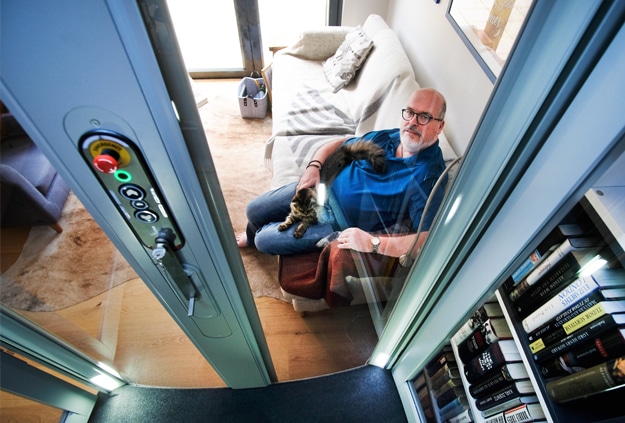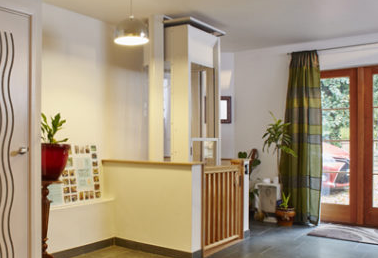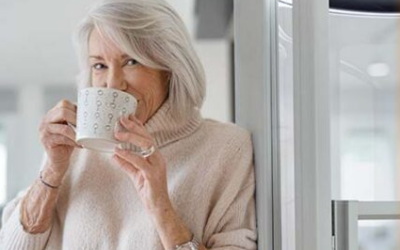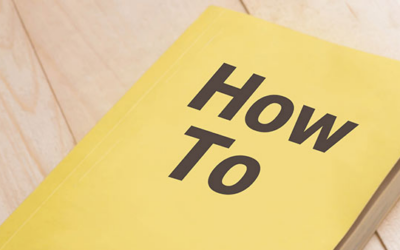Safety on Stairs – an illustration of how home lifts deliver better occupational performance in the community
If mobility becomes challenging due to age, disability, or health issues, use of stairs can increase the risk of injury in the home. Relevant home adaptations can prevent trips and falls, leading to increased independence and mental wellbeing. The NHS states that around 1 in 3 over 65’s will fall at least once a year at home and fifty per cent will fall more frequently. Reducing stair-related falls not only releases pressure on GPs, the NHS and social care system; it promotes health self-management and secures independent living in accessible homes.
Importance of Safety on Stairs
According to The Royal Society for the Prevention of Accidents, (ROSPA), the most serious accidents involving older people usually happen on the stairs or in the kitchen. The largest proportion of accidents are falls from stairs or steps with over 60 per cent of deaths resulting from accidents on stairs. Stair-related accidents and injuries in turn place significant financial pressures on health and social care services. Older clients with weakened joints and bone density may face an increased risk of injury from a stair-related fall including fractures, head injuries and serious lacerations.
Compromised Mobility
Unstable balance, lack of strength, failing vision, and low confidence levels can increase the likelihood of a trip, slip or fall. Many stairwells which are steep and narrow can be particularly challenging for people with mobility issues due to age, chronic illnesses such as Parkinson’s, arthritis and multiple sclerosis. Shallow stair treads can also make it difficult for users to place their foot at the correct angle fully.
Some clients may also choose to descend the stairs backwards or in a seated position which causes further risk of falls. Your client may also experience the anticipated fear of falling on stairs which can negatively affect mental health and wellbeing. A Stiltz Duo+ can successfully reduce stair-related incidents and reduce reliance on carers and family members.
Wheelchair Users
If your client requires the use of a wheelchair, a home lift such as a Stiltz Trio+ would be an advantage. It would provide independent movement between floors. A stairlift would require space for two wheelchairs (one at the top and one at the bottom of the stairs), and your client would require the ability to be able to transfer independently to the stairlift seat. A Stiltz Trio+ ensures easy access for manual wheelchairs, powerchairs and walkers, and two people can travel at the same time.
Sight Loss
A study by the Pocklington Trust, exploring stair falls and lighting in the homes of older people with sight loss states: ‘Using stairs is one of the most challenging activities older people encounter on a daily basis. Previous research has shown that stair-related injuries in people aged 75 and older are five times greater than those in young people. In addition, these injuries can lead to hospitalisation in older people, impacting on their quality of life and independence’.
Accessible Housing Facts
- According to The Centre for Ageing Better ninety per cent of England’s older population live in mainstream housing rather than specialist housing or care homes.
- Despite changes in mobility, many clients will prefer to remain in their own home as opposed to relocating. Later-living accommodation is in short supply, as well as being a costly option.
- Around 3 million people over 65 live in homes larger than they require which are often unsuitable for their changing needs and aspirations.
Home Lifts Vs Stairlifts
Specialist home adaptations can enable assisted living, and the installation of a home lift can solve many stairwell usability issues, providing safe, independent access to multi-floor homes. A home lift is a cost-effective alternative to building an additional downstairs wet-room and/or bedroom.
It will also future-proof your client’s home, unlike a stairlift. Stairlifts may become unusable if mobility issues worsen and your client may find transferring to and from the stairlift seat difficult unaided. Stairlift seats and rails could also cause potential issues for other members of the household as they can encroach on the stairwell space.
An Occupational Therapist’s View
Stuart Barrow, respected Occupational Therapist and founder of the Occupational Therapy Adaptation Conferences (OTAC) comments:
Unfortunately, stairlifts will have limits and do not solve all personal requirements. A few years back, a through-floor lift (home lift) would be a huge hole in the ceiling which could cause structural concerns and intrusion. Plus, they were often unaffordable and not suitable for many smaller-sized homes.
Now, proven home lifts, such as a Stiltz Home lift, are much easier to fit into a wider range of properties and are within budget – whether via private purchase or through a Disability Facilities Grant (DFG). Following a client assessment, if the requirement is deemed urgent, the home lift can be fast-tracked for building work, installation and set-up, within a matter of days.
As Occupational Therapists, we consider many factors – the environment and people’s occupation, as well as self-care, productivity and leisure. When a home becomes inaccessible, and it is no longer viable for occupants to safely utilise a stairwell, we face having to consider the client living on the ground floor which is not ideal, or we consider a move to a more suitable property – potentially away from friends, their family and medical professionals they are often involved with. By installing a home lift, we can enable people to remain safely within their own home, close to their support network.

Stair-related accidents and injuries in turn place significant financial pressures on health and social care services.







